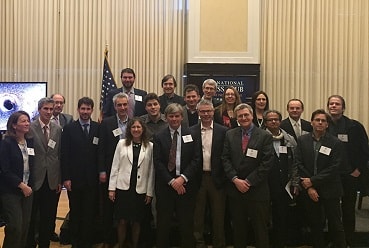
US scientists Rainer Weiss, Barry Barish and Kip Thorne won the 2017 Nobel Prize for Physics for their pioneering role in the detection of gravitational waves.
Ripples in the fabric of space-time first predicted a century ago by Albert Einstein, gravitational waves sparked a revolution in astrophysics when their first detection was announced early last year.
The teams involved in the discovery quickly emerged as favourites for the prize.
They are receiving the prize for the discovery of the gravitational waves released by violent events in the universe such as the mergers of black holes.
The first time this was detected was on September 14, 2015, by the LIGO-VIRGO collaboration. Since then three more detections have been made, the latest one on September 28, 2017.
The discovery is due to an extremely delicate experiment. Gravitational waves were predicted by Einstein almost 100 years ago.
After about 50 years of experimentation the waves were detected for the first time in September 2015.
The 2016 prize went to three British-born researchers who applied the mathematical discipline of topology to help understand the workings of exotic matter such as superconductors and superfluids.
The 2017 Nobel medicine prize went on October 2 to three Americans studying circadian rhythms, better known as body clocks- Jeffrey C. Hall, Michael Rosbash and Michael W. Young.
Physics is the second of this year's crop of Nobel Prizes.
The prizes for achievements in science, literature and peace were first awarded in 1901 in accordance with the will of Swedish business tycoon Alfred Nobel, who bequeathed much of the fortune he generated from his discovery of dynamite.
LIGO Research: Know More- The discovery and the repeated detection (four times now) has made the possibility of gravitational wave astronomy very real.
- Gravitational wave astronomy is a way of mapping out some of the most violent processes in the universe such as black hole or neutron star mergers that cannot be detected with light or the conventional methods.
- The discovery can pave the way for proving the general theory of relativity, so that we can look deeper and deeper into the universe. It also throws up the possibility of detectors that can look at the beginning of the universe.
- The scientists in the collaboration are from five continents, over 1,000 in number.
- In the 1970s, Dr. Weiss designed a laser-based device that would overcome background noise that would disturb measurements of gravitational waves.
- He, Dr. Thorne and Dr. Barish “ensured that four decades of effort led to gravitational waves finally being observed,” the Nobel announcement said.
- Einstein was convinced that gravitational waves could never be measured. The laureates used laser devices “to measure a change thousands of times smaller than an atomic nucleus,” it said.
- Triggered when super-dense black holes merge, the waves were detected using laser beams at the Laser Interferometer Gravitational-Wave Observatory (LIGO).